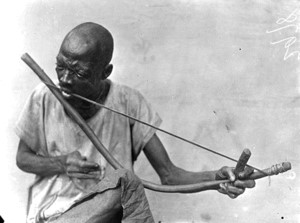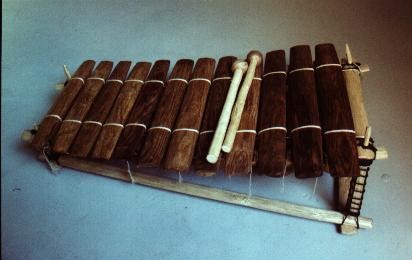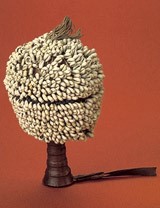Resource 5: Traditional musical instruments
![]() Background information / subject knowledge for teacher
Background information / subject knowledge for teacher
Nigeria's traditional music uses a number of diverse instruments. Many, such as the xylophone [Tip: hold Ctrl and click a link to open it in a new tab. (Hide tip)] , are an integral part of music across West Africa, while others are imports from the Muslims of the Maghreb, or from Southern or East Africa; other instruments have arrived from Europe or the Americas. Brass instruments and woodwinds were early imports that played a vital role in the development of Nigerian music, while the later importation of electric guitars spurred the popularisation of jùjú music.
Nigerian musical bow
The musical bow is found in Nigeria as a mouth-resonated cord, either plucked or struck. It is most common in the central part of the country, and is associated with agricultural songs and those expressing social concerns.

Cereal stalks bound together and strings supported by two bridges are used to make a kind of raft-zither, played with the thumbs, typically for solo entertainment. The arched harp is found in the eastern part of the country, especially among the Tarok. It usually has five or six strings and pentatonic tuning. A bowl-resonated spike-fiddle with a lizard skin table is used in the northern region; it is an import from North Africa, and is similar to central Asian and Ethiopian forms. The Hausa and Kanuri peoples play a variety of spike-lutes.
Xylophone
The xylophone is a tuned idiophone, common throughout west and central Africa. In Nigeria, they are most common in the southern part of the country, and are of the central African model. Several musicians sometimes simultaneously play a single xylophone. The instruments are usually made of loose wood placed across banana logs. Pit- and box-resonated xylophones are also found.

Adapted from: Africa Alive, Website
Various bells are a common part of royal regalia, and were used in secret societies. They are usually made of iron, or in Islamic orchestras of the north, of bronze. Struck gourds, placed on a cloth and struck with sticks, are a part of women's music, as well as the bòòríí cult dances. Sometimes, especially in the north, gourds are placed upside down in water, with the pitch adjusted by the amount of air underneath. In the south-west, a number of tuned gourds are played while floating in a trough.
Nigerian rattle
Scrapers are common throughout the south. One of the most common types is a notched stick, played by dragging a shell across the stick at various speeds. It is used both as a women's court instrument and by children in teasing games. Among the Yoruba, an iron rod may be used as a replacement for a stick. Rattles made of gourds containing seeds or stones are common, as are net-rattles, in which a string network of beads or shells encloses a gourd. Rattles are typically played in ritual or religious context, predominantly by women.

Adapted from: Aberdeen University, Website
Nigerian Udu drum
Drums of many kinds are the most common type of percussion instrument in Nigeria. They are traditionally made from a single piece of wood or spherical calabashes, but have more recently been made from oil drums. The hourglass drum is the most common shape, although there are also double-headed barrel drums, single-headed drums and conical drums. An unusual percussion instrument is the udu, a kind of vessel drum.
The udu is a Nigerian clay drum that evolved from a water jug with another hole in the side. It was created many years ago by Igbo women who used it as a musical instrument for ceremonial occasions. Udu means both pot and peace in the Ibo language of Nigeria.

Adapted from: Woodbrass, Website
The udu has become a popular instrument in the West and is often used on movie soundtracks. Many modern versions of the udu are being produced today. They have a wider range of tones than the traditional instrument.
Adapted from: Wikipedia, WebsiteResource 4: Ideas for judging each instrument



